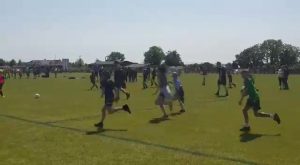Soccer training encompasses a wide range of activities and exercises aimed at developing the skills, fitness, and tactical understanding necessary for success on the soccer field. The objectives of soccer training are to improve technical proficiency in handling the ball, passing, shooting, and defending; enhance physical fitness, including speed, agility, endurance, and strength; and foster tactical awareness, decision-making, and teamwork.
Technical Training:
Technical training focuses on developing the individual skills players need to control the ball and execute various techniques. This includes:
- Drills for ball control, such as juggling and dribbling, to enhance players’ ability to manipulate the ball with their feet.
- Passing exercises to improve accuracy, distance, and timing, ensuring effective passing combinations during gameplay.
- Shooting drills to develop players’ ability to score goals with power, accuracy, and the ability to curve the ball.
- Defending drills to teach players proper tackling techniques, positioning, and how to read opponents’ moves.
Physical Training:
Physical training plays a crucial role in soccer, as players require a high level of endurance, speed, agility, and strength to perform at their best. This may include:
- Aerobic training exercises such as running, interval training, and endurance drills to build cardiovascular fitness and stamina.
- Speed and agility drills to enhance players’ acceleration, top speed, and ability to change direction quickly.
- Strength training exercises, including weight lifting, plyometrics, and core work, to develop muscular strength and power.
Tactical Training:
Tactical training aims to develop players’ understanding of formations, game strategies, and the ability to make quick decisions on the field. It covers:
- Position-specific tactics, teaching players their roles and responsibilities within different formations.
- Attacking and defending strategies to help players understand offensive and defensive patterns of play.
- Set-piece tactics to practice corner kicks, free kicks, and penalty kicks effectively.
- Game simulations and small-sided games to allow players to apply tactical concepts in a competitive environment.
Additional Aspects of Soccer Training:
Beyond technical, physical, and tactical training, soccer training can also include:
- Mental and psychological training to help players manage stress, build resilience, and enhance concentration during games.
- Tactical flexibility exercises to equip players with the ability to adapt to different game situations and formations.
- Injury prevention and recovery protocols to minimize the risk of injuries and facilitate faster recovery.
Overall, soccer training is a comprehensive approach that combines technical, physical, tactical, and other aspects to develop well-rounded players capable of performing at a high level on the field.



